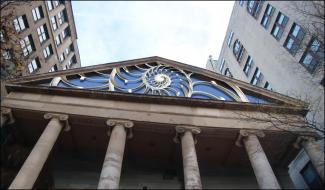Following a national search and selection process involving members of the diocese and experts in contemporary art and sculpture, Philadelphia artist Donald Lipski was chosen in March to complete the pediment of the Cathedral Church of St. Paul—empty and unfinished since its builders ran out of money 190 years ago.
In the triangular plane over the church’s columned porch—where the original plans called for a bas relief carving typical of Greek Revival buildings (in this case depicting St. Paul testifying before King Agrippa)—Lipski’s proposal instead incorporates a sculptural cross-section of a nautilus shell against a Madonna-blue field, to be backlit at night.
The idea came to him right away, Lipski said, as he began to think about the cathedral church’s mission as “a house of prayer for all people.”
“I wanted to find a symbol, an image, that would speak to everyone and be beautiful. The spiral came to mind really almost immediately because I started to think of the classical proportions of a Greek temple, based on the [mathematical] golden rectangle which yields the spiral,” Lipski told a group of potential donors gathered at the cathedral church for a preview in late March.
“The spiral is the most ubiquitous shape in the universe. It’s in the movement of subatomic particles and it’s in the vastness of galaxies. So if you’re thinking about God, or even if you don’t believe in God, the spiral, I think, can still speak to people,” Lipski said.
Cathedral dean Jep Streit said it was just that sort of public voice that the selection committee wanted for this architecturally important building—the first Greek Revival one in Boston—fronting the country’s oldest public park.
A sculpture that can preach, in other words.
And while the proposed sculpture has nothing to do with silent stone figures from the biblical scene originally envisioned for the pediment, one might say it has everything to do with what Paul actually said that day before Agrippa as he appealed for freedom by preaching the story of his own conversion in Christ while journeying along the road to Damascus.
At the preview gathering, Lipski recounted a serendipitous encounter during his first visit to the cathedral church last November. “I went for a walk in the Boston Common to see what the cathedral looked like from a distance. And there was a woman who had made a spiral in the leaves, and she was walking back and forth as if in a labyrinth,” he recalled. “I took this as almost a sign that my inspiration made sense right here, right now. We’re all on a path, and like in a labyrinth, we spiral towards our own center and we spiral out into the world, and the spiral really is a symbol for the spiritual journey.”
Streit said it also has to do with invitation. “I’m mindful of Jesus’ words to invite the disciples in the Gospels. He says: Come and see. And this exactly says that,” Streit said of the sculpture.
The hope, he said, is for its installation to be finished this fall, in time for the Diocesan Convention hosted by the cathedral church Nov. 2-3.
“One of the things I’m impressed by about Donald is that he’s got significant installations in major places, so he’s able to do what he envisions, which is really important,” Streit said. “I think this will transform the cathedral.”
Donald Lipski’s work is in the permanent collections of numerous museums, including the Metropolitan Museum of Art and the Chicago Art Institute. He’s also known for numerous public sculptures, among them,“Sirshasana,” the upside-down olive tree “chandelier” in the Lexington Avenue entrance of Grand Central Terminal in New York.
“The Ship of Pearl”—the title Lipski has given the cathedral sculpture proposal, from Oliver Wendell Holmes’s poem, “The Chambered Nautilus,”—is the first time Lipski has done a project for a church or religious entity, he said in an interview.
“Typically the works I do, they’re in airports, they’re in bus stations, convention centers, and sometimes with a great deal of importance in that they give the place an identity or they act as a symbol or sign for the place,” he said. “But it’s different in a church. It’s really a stretch to try to make something that’s appropriate for such a weighty situation, that means so much to so many people, that has a historical spot in its geography,” he said.
It’s the “enormity of the challenge,” he said, that drew him to this project. “I’m thrilled to be doing it, and I know that it will end up being one of the things of which I’m most proud,” he said.
The pediment project is the first part of the more extensive renovations to the Cathedral Church of St. Paul that will be made possible by $4 million from the $20-million diocesan Together Now fundraising campaign that is now underway. Those plans include replacing the box pews with kneeler chairs around a central altar, so that the liturgical space will be adaptable for varied use; a glass-walled entrance and chapel area that will make the indoor life of the church more visible and inviting to the world outside; skylights to bring in natural light; energy-efficiency improvements to the heating system; and a new elevator to improve accessibility.
Renovations are scheduled to begin early in 2013.
--Tracy J. Sukraw
Listen to excerpts from an interview with Donald Lipski here.
Read the news release announcing the pediment proposal here.


